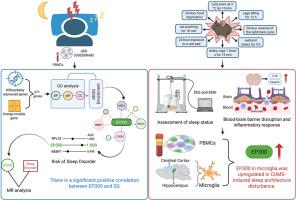EP300 as a potential mediator of stress-induced sleep disruption through blood-brain barrier dysfunction and neuroinflammation
IF 3.4
2区 医学
Q1 CLINICAL NEUROLOGY
引用次数: 0
Abstract
Sleep disorders (SDs) are complex and multigenic, and their pathogenesis remains unclear. This study sought to identify key genes influencing SDs to offer new perspectives on understanding, preventing, and treating the disorder. Differential expression and weighted gene co - expression network analyses were employed to find susceptibility modules and hub genes related to SDs. The Kyoto Encyclopedia of Genes and Genomes and Gene Ontology analyses were used to explore the functions and mechanisms of these hub genes. Mendelian randomization was carried out to assess the causal relationship between EP300 and SDs. We identified a total of 371 key genes associated with multiple biological processes. Five hub genes were identified, and a positive correlation between EP300 and SD risk was confirmed. In a mouse model of chronic unpredictable stress with sleep architecture disturbance, bioinformatics findings were validated using qPCR experiments and single-cell RNA sequencing of the prefrontal cortex. We found that EP300 expression was significantly increased in microglia of the model mice, coinciding with blood-brain barrier disruption and elevated IL-1β mRNA expression. This study first revealed the potential role of EP300 in SD.

EP300可能通过血脑屏障功能障碍和神经炎症介导应激性睡眠中断
睡眠障碍是一种复杂的多基因疾病,其发病机制尚不清楚。本研究旨在确定影响SDs的关键基因,为理解、预防和治疗该疾病提供新的视角。采用差异表达和加权基因共表达网络分析,寻找与SDs相关的敏感性模块和枢纽基因。利用《京都基因与基因组百科全书》和基因本体分析对这些枢纽基因的功能和机制进行了探讨。采用孟德尔随机化方法评估EP300与SDs之间的因果关系。我们共鉴定出371个与多种生物过程相关的关键基因。发现5个枢纽基因,证实EP300与SD风险呈正相关。在慢性不可预测应激伴睡眠结构障碍的小鼠模型中,生物信息学研究结果通过qPCR实验和前额皮质单细胞RNA测序得到验证。我们发现EP300在模型小鼠的小胶质细胞中表达显著增加,与血脑屏障破坏和IL-1β mRNA表达升高相一致。本研究首次揭示了EP300在SD中的潜在作用。
本文章由计算机程序翻译,如有差异,请以英文原文为准。
求助全文
约1分钟内获得全文
求助全文
来源期刊

Sleep medicine
医学-临床神经学
CiteScore
8.40
自引率
6.20%
发文量
1060
审稿时长
49 days
期刊介绍:
Sleep Medicine aims to be a journal no one involved in clinical sleep medicine can do without.
A journal primarily focussing on the human aspects of sleep, integrating the various disciplines that are involved in sleep medicine: neurology, clinical neurophysiology, internal medicine (particularly pulmonology and cardiology), psychology, psychiatry, sleep technology, pediatrics, neurosurgery, otorhinolaryngology, and dentistry.
The journal publishes the following types of articles: Reviews (also intended as a way to bridge the gap between basic sleep research and clinical relevance); Original Research Articles; Full-length articles; Brief communications; Controversies; Case reports; Letters to the Editor; Journal search and commentaries; Book reviews; Meeting announcements; Listing of relevant organisations plus web sites.
 求助内容:
求助内容: 应助结果提醒方式:
应助结果提醒方式:


